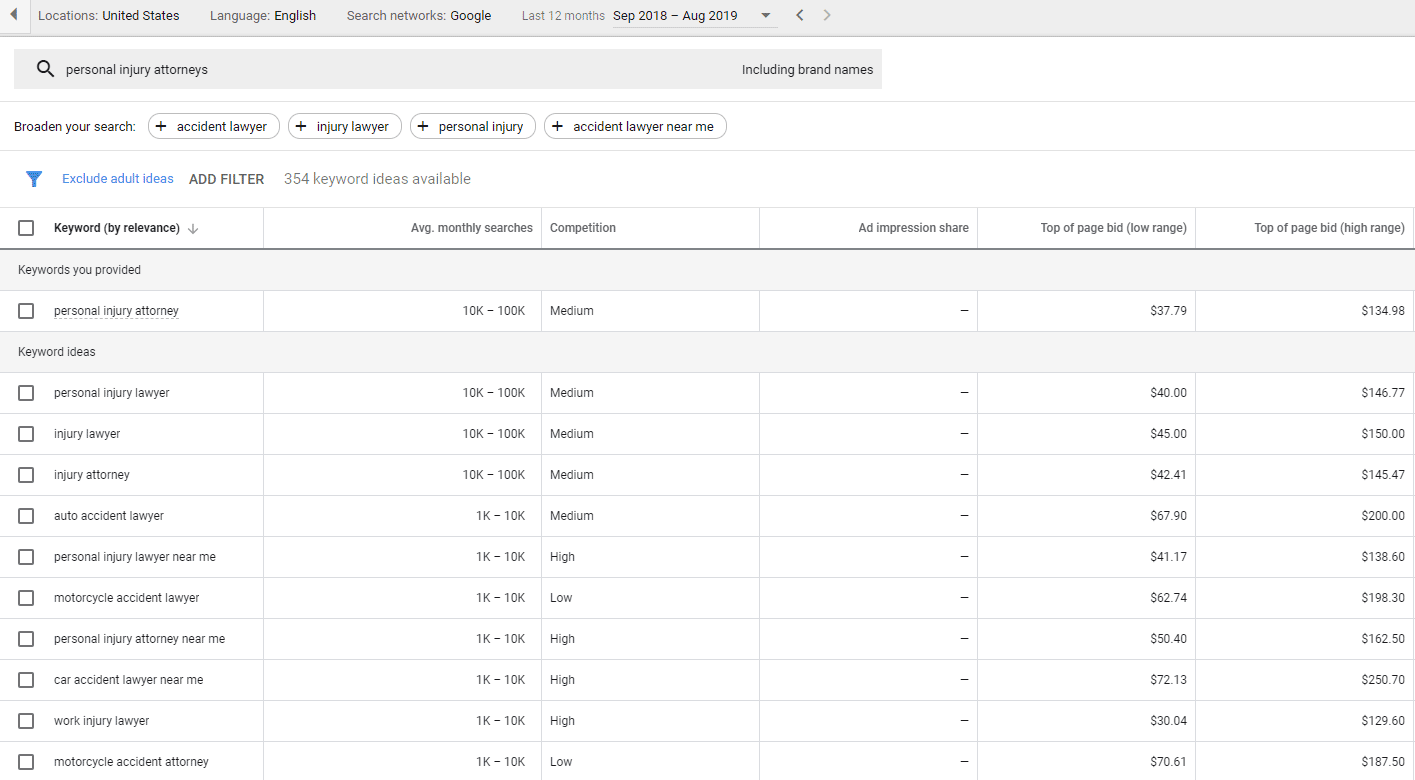Whether you’re an attorney or legal marketing firm tasked with bringing in new clients, you can’t afford to ignore SEO. Nothing attracts warm leads like being in front of a prospect right as they’re searching for legal services like yours or your client’s.
If you want to try your hand at improving your law firm’s search engine visibility, we’ve put together a 7-step law firm SEO plan for you to follow.
7 Steps to Better Law Firm SEO & More Client Leads
Here are seven key areas to focus on if you want search engines to deliver more highly-targeted leads to your law firm.
1. Target the Right Legal SEO Keywords
You can’t just put a bunch of copy and content on your law firm’s website and hope for the best. Good SEO involves knowing your target market and catering to the kinds of keyword phrases they search for.
Keyword Research Tips & Resources
To get an idea of what your potential clients are searching for, you’ll want to use keyword research and suggestion tools. Here are two that can help you create more focused content:
The Google Ads Keyword Planner not only gives you insight into search volume, but it also provides related keyword suggestions. Here’s an example results page related to “personal injury attorneys.”
 Answer the Public is better for coming up with “long tail” keyword phrases. These are simply longer phrases or sentences. They might receive fewer searches each month, but you can target many throughout your law firm’s site.
Answer the Public is better for coming up with “long tail” keyword phrases. These are simply longer phrases or sentences. They might receive fewer searches each month, but you can target many throughout your law firm’s site.
For example, you might use the questions this tool generates as blog post titles, answering these FAQs for your target clients.
 This tool provides several suggestions in a visual format as you can see above. Or you can download lists of phrases if you prefer.
This tool provides several suggestions in a visual format as you can see above. Or you can download lists of phrases if you prefer.
A Word of Warning: Avoid Keyword-Stuffing
In the early days of SEO, “keyword-stuffing” was a popular tactic. This involved using the same keyword phrase many times on a page.
The problem is keyword-stuffing makes your content less user-friendly. It also violates Google’s quality guidelines. These days keyword-stuffing doesn’t work, and it lowers the overall credibility of your site.
2. Focus on Onsite SEO
Once you’ve identified the keyword phrases you want to target, the next thing to work on is onsite SEO.
What is Onsite SEO?
Onsite search engine optimization includes all the things you do on your site or page itself to show search engines it’s an authority resource that should rank well.
In other words, you have to help Google understand your content. Here are some ways you can do that:
- Make sure every page has a relevant title tag.
- Add a meta description to every page.
- Optimize your URL (decide if you want to eliminate stop words and include your primary keyword phrase).
- Make sure your focus keyword phrase appears early in your content and within heading tags.
- Include synonyms and related keyword phrases as well.
- Add relevant internal links within your content (link to other pages on your site).
- Include external links to authoritative sites when it makes sense to (only the best sources, such as legal texts on government websites; your main focus is still converting prospects on your own site).
- Optimize your images by including alt text.
- Make your website mobile-friendly. (At least 70% of internet access is now from mobile devices.)
- Speed up your website. (Website speed is a Google ranking signal.)
3. Spend Some Time on Local Law Firm SEO
As an attorney, you’re likely focused on a local or regional market more than a national or global one. That means it’s important for you to rank well in local search results.
This is when someone searches for something like “divorce attorneys in Seattle” or “estate planning lawyer near me.” With these local searches, Google highlights the top three local results and pinpoints them in Google Maps.
Local SEO can literally send new clients to your door.
Here are some things you can do to improve local search engine optimization for your law firm:
- Set up your free Google My Business
- Add your address, phone number, business hours, and email address to your website.
- Submit listings to directories (local or legal industry directories) that include your address.
- Make sure your address is formatted the same anywhere it’s cited online.
- Create content targeted not only to specific keywords and services, but also targeted to your local market.
- Encourage your clients to leave online reviews of your firm.
In addition to specialized directories, consider posting a listing in more general directories as well, DSS MEDIA’s site DirJournal.com, for example, has a “lawyers and firms” section dedicated to helping people find attorneys.
4. Create a Collection of Quality Legal Content
One of the best ways to improve search rankings is to publish more content. It should help your target clients in some way – solving a problem or answering a question. Quantity isn’t enough though. To rank well, you’ll want to demonstrate your expertise with high-quality authority content.
Depending on the type of legal clients you work with, this might include:
- regular blog posts;
- white papers;
- downloadable guides or e-books;
- FAQs.
Remember, every article and other piece of content can target a different keyword phrase. This is where the long tail keywords we talked about earlier come into play.
5. Scale Up Your Legal SEO Efforts with Structured Data
Structured data is when you use markup in your code to better help search engines like Google understand what your content actually means. A primary example of this is schema markup. (This is a specific set of markup language.)
Google will see this markup code and immediately know what the content it tags represents. For example, you might use the following “LegalService schema” on your firm’s site.
- Address
- Telephone
- FaxNumber
- MemberOf (associating you with professional organizations)
- OpeningHours
Schema markup can also be used on different types of content on your firm’s site. For example, there’s specialized markup available for:
Why should you bother to focus on structured data like schema markup?
The more search engines understand the content on your law firm’s website, the better your chances of ranking well and reaching more potential clients.
Google also uses this markup in certain types of specialized search results. For example, adding job listing markup to open positions on your firm’s “Careers” page means they could end up in Google’s job search results like the ones below.
 6. Build Backlinks to Your Law Firm Website
6. Build Backlinks to Your Law Firm Website
Earlier, we looked at onsite SEO. But you’ll also want to think about offsite SEO. This will largely involve building backlinks that point to your firm’s website.
When you publish high quality content, you’ll earn natural backlinks over time. But there are some things you can do to build backlinks faster while you wait for your content strategy to pay off.
For example:
- If you notice third-party resources related to your firm have broken links, you can contact the site owners and see if they’re willing to link to your site instead.
- You can conduct competitive research using a tool like BuzzSumo to identify sites linking to your competitors. Then contact them to request a link to your site as well where appropriate.
- Contribute to industry publications – from trade publications to blogs. You’ll often get a link from any online versions.
- Seek out earned media opportunities that might result in a link. For example, register as a source and respond to relevant journalists’ questions through HARO.
- Share your content on social media.
- Submit your law firm’s listing to local or niche legal directories.
- Create natural linkbait This might be an e-book, a white paper, long-form comprehensive blog posts, or infographics.
Building, and earning, backlinks isn’t a one-off proposition. If you want ongoing successful SEO results for your law firm’s website, this is something you’ll continually work on.
7. Add PPC Advertising to Your Search Engine Marketing Mix
While pay-per-click (or PPC) advertising isn’t technically SEO, it’s still a part of your larger search engine marketing mix. When you’re getting started with building search engine visibility, this can be the fastest way to reach new prospects.
PPC advertising is simply when you purchase space alongside organic search results (or in advertisements on other content-based sites through a service like Google Ads). You pay for those ads based on the number of leads who click on them to visit your website.
Even better, advertisers using Google Ads see a $2 value for every $1 they spend in ad buys.
PPC advertising complements your organic SEO work, helping you fill in gaps or drive more leads when you need them most. And because these are people actively searching for the target keyword phrases you choose, they come to you as already-warm leads ready to be converted into clients.
When to Bring in the Law Firm SEO Experts
Does legal SEO sound complicated?
Some of it can be. But even if you focus on the most basic steps like conducting keyword research and getting your onsite SEO under control, you can see better results.
If you want to go beyond that though, you might want to bring in search engine optimization and PPC experts like the team here at DSS MEDIA. After all, you’re busy running your law firm.
Spend more of your time on billable work with your law firm’s clients and less worrying about your website rankings. Contact us today for a free SEO analysis or to request a quote for SEO management.

